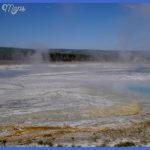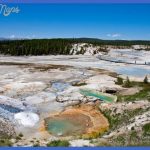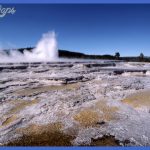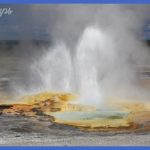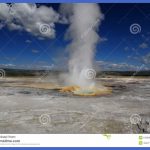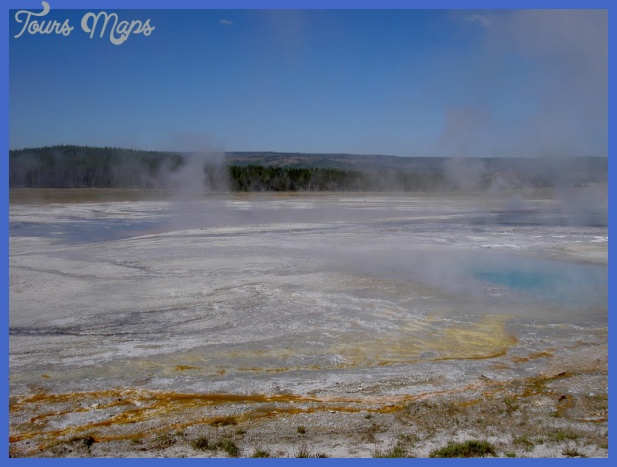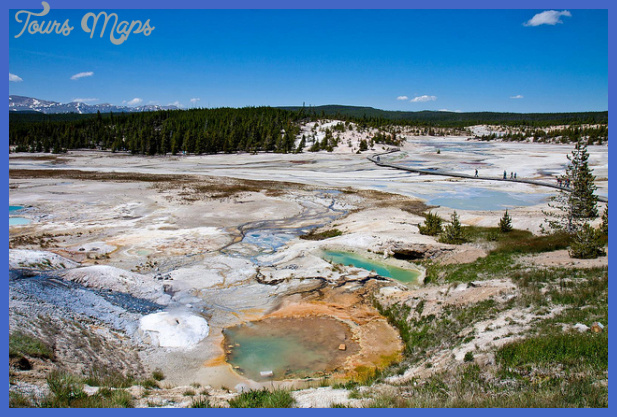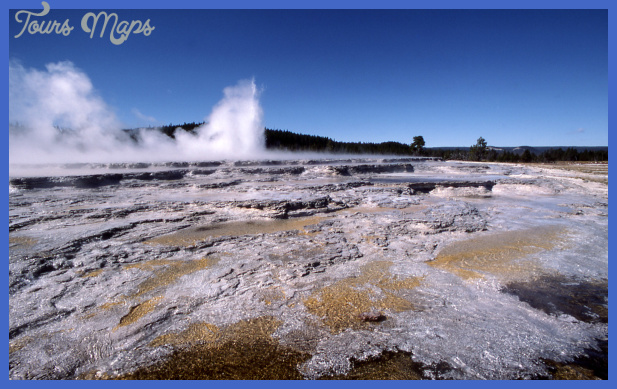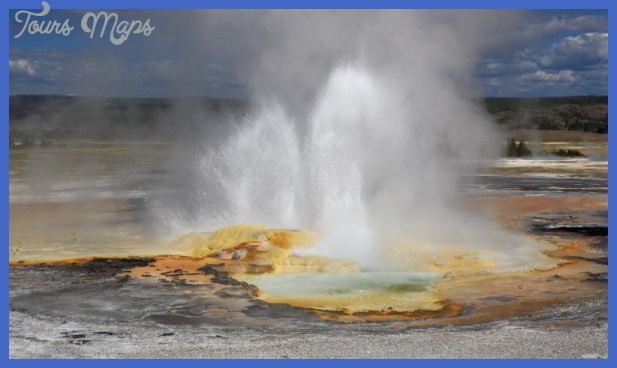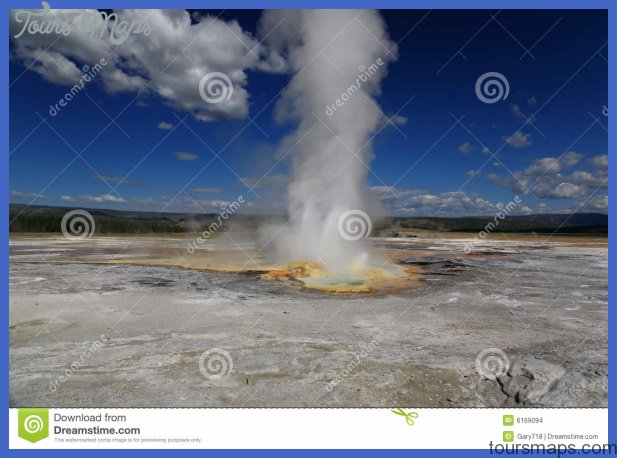Seventeen hot spring groups covering about 5 square miles (13 sq km) nestle in the valley of Lower Geyser Basin. Not all are accessible by trail or boardwalk. The basin’s most popular feature is Great Fountain Geyser, which is easy to reach on Firehole Lake Drive (at mile 9.0/8.0). At Great Fountain expect to see some of the world’s most exciting geyser eruptions. Near the Fountain Hotel site (see below) is the Thud Group of thermal features in an area closed to the public. Looking east from the road, you might see frequently erupting Kidney Spring and Thud Spring, notable for the 1948 cleaning-out it was given by ranger George Marler. He found an amazing hodgepodge of things in it, including a pitchfork, a 40-gallon metal drum, a tree, and a section of a 1913 guidebook! Historical Fountain Hotel The Fountain Hotel, located less than one-half mile (0.8 km) from the Fountain Paint Pot area of the basin, opened in 1891. It was an unusually elegant place for its remote location, having electric lights, steam heat, and hot spring water in the baths. It was the place where bears were first fed hotel garbage to entertain the tourists. In 1917, when motorization of park transportation made a hotel here unnecessary, Fountain Hotel was permanently closed. Leather Pool provided hot water to the Fountain Hotel (Ely Cook photo).
Fountain Paint Pot Loop Walk
Visitors in wheelchairs should be aware that there are stairs at the point farthest from the parking lot. Celestine Pool (probably from Latin celestinus, meaning heavenly or sky blue) is the large, quiet pool nearest the parking lot. A tragic event occurred here in 1981, when a young man tried to rescue his dog after it jumped into the pool. Both man and dog died as a result of contact with the scalding water. Walking straight up the boardwalk, you come to Silex Spring, a large, pale blue pool that sometimes erupts as a geyser. Silex means silica in Latin. Although called a spring, Silex was known to erupt until 1979, then reactivated in 2000 and continues to have periods of activity.
The largest easily accessible paint pot in the park. A paint pot is an area of hot mud delicately tinted by iron oxides. Bubbles of carbon dioxide and rotten-egg-smelling hydrogen sulfide gases escape through fine clay and silica. The paint pot’s fascinating bubbling activity is dependent upon the amount of ground water available, which usually decreases as summer progresses. Overall, Fountain Paint Pot’s area is gradually increasing, and the boardwalk has to be moved periodically to accommodate it. A 19th century visitor, Gen. John Gibbon, remarked that the paint pots are like a group of politicians, each one trying to outdo the other and he said something about mudslinging in the same connection. At the top of the hill, you can often hear a loud, high-pitched, and persistent hissing sound coming from a jumble of rocks next to bubbling mud. This is a fumarole, a vent where steam and other gases escape from deep underground. When water from rain and snow seeps down from the surface, it flashes into gas as it meets the extremely hot rock below.
Red Spouter formed in a grassy area soon after the 1959 Hebgen Lake earthquake. When the water table is high, its two large vents or pools are perpetual spouters. A perpetual spouter erupts continuously. When there’s less water, Red Spouter’s pools become noisy fumaroles. The gray crater sometimes sports bright red patches. Leather Pool was named for the brown bacteria that used to line it. But after the 1959 Hebgen Lake earthquake, it became a clear blue pool. The brown color has returned to the rocks lining the pool, but the water remains fairly clear. A trace of the former pipeline to Fountain Hotel can still be seen. At a slightly lower level, you’ll pass Fountain Geyser (not the same as Great Fountain Geyser) to the north of the boardwalk. It and sometimes its neighbor Morning Geyser were major attractions for the hotel guests rather like Old Faithful still is today for guests at Old Faithful Inn. A Fountain Hotel guest of 1899 wrote a vivid description of an eruption of Morning Geyser. Guests were aroused about midnight one August night by gongs and bells and porters shouting, The new geyser is playing! Tourists rushed to the geyser basin in all states of dress and undress. Upward into the black night shot a stupendous column of water three hundred feet high.
The porters were the first to arrive and playing their red calcium lights on the wonderful body of falling water gave us a display of fire and water that must be seen to be appreciated. When active, Fountain may erupt as high as 100 feet (30 m). Since both Fountain and Morning geysers have years-long dormant periods, catching one or both erupting is a treat you can’t count on. However, Fountain was recently erupting quite regularly every 5 to 7 hours. The geysers of the Fountain Group are interdependent, exhibiting what scientists call exchange of function. This means that the underground plumbing of each influences the others a great deal. These geysers are consequently irregular and mostly unpredictable. Geysers of two other groups, the Kaleidoscope and Sprinkler groups, can sometimes be seen erupting as you stand on the boardwalks above or near Fountain. There has been more activity in this area in the past few years than ever before, according to those who’ve been watching closely. Twig Geyser, at the base of the steps, can be seen erupting a few feet high (a meter or two) about half the time. Jet Geyser built its formation from six vents along a long break in the sinter. It erupts every few minutes up to 20 feet (6 m) high when either Fountain or Morning geyser is active.
Spasm Geyser (near the bend in the boardwalk) plays about 3 feet high (1 m), often beginning to erupt 2 or 3 hours before Fountain. Spasm has a yellow-stained cone and pale green water. Its rocky edge is the result of a hydrothermal explosion this geyser experienced over 30 years ago. Clepsydra Geyser (pronounced CLEP-si-drah), farther from the boardwalk than Spasm Geyser, clearly exhibits the geysers’ exchange of function. If Fountain Geyser is not active, Clepsydra rarely stops playing, but when Fountain is active, Clepsydra sometimes pauses. Before Fountain reactivated in the late 1990s, Clepsydra’s spurts were as high as 45 feet (14 m); lately they have been lower. Clepsydra is the ancient Greek word for water clock (literally, to steal water). The name was applied to this geyser in the 1870s, because at that time its eruptions could be expected regularly every 3 minutes. As you tour the park you’ll find that early park explorers, ocials, and guides drew on their classical education, choosing Greek and Latin names for many features. Jelly Spring (its ocial name, although it has sometimes erupted as a geyser) becomes lined with thick, jelly-Clepsydra Geyser erupts from two major jets and several minor ones. Spasm Geyser’s two vents are in the foreground.
Lower Geyser Basin Photo Gallery
Maybe You Like Them Too
- The Best Cities To Visit in The World
- World’s 10 Best Places To Visit
- Coolest Countries in the World to Visit
- Travel to Santorini, Greece
- Map of Barbados – Holiday in Barbados

